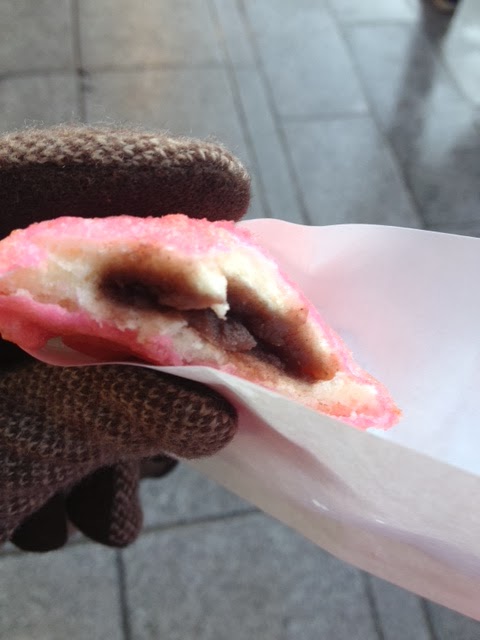Dying for some fast facts?
- Constructed in 645 (completion date), it is the oldest Buddhist Temple in Japan
- The temple is dedicated to Kannon, the goddess of mercy and compassion
- Legend has it that the temple was constructed in her honor after her statute repeatedly appeared in front of two fisherman in a nearby river (even after they originally sent the statute on down the river)
- The entrance to Senso-ji is called Kaminarimon (かみなりもん), which means Thunder Gate
- Kaminarimon, which was originally built in 941, relocated in 1635 and destroyed and rebuilt several times since, is guarded by Fujin, the god of wind, and Raijin, the god of thunder
We relied on our handy Pocket Tokyo guidebook by Lonely Planet (thanks to Gina and Daniel!) and approached the temple through かみなりもん and proceeded to walk down Nakamise-dori, an old shopping street selling sweets and traditional Japanese wares among other things.
View down Nakamise-dori to Senso-ji.
We passed so many delicious smelling sweet, and I vowed to get one on my way out after I had a chance to peruse all the offerings. I ended up getting an agemanju glazed with Japanese apricot confection. Agemanju is deep fried rice flour bun stuffed with azuki bean paste. Um, yes, it was everything that a sweet should be, and it was delicious down to the bean paste.
The vendor sold many flavors including pumpkin and black sesame. I went with Japanese apricot because it sounded traditional enough and decidedly delicious. But, I have since learned that Japanese apricots (or prunus mume) were originally introduced from China, though that was centuries ago.
Now, to the main attraction, Senso-ji. The first sight that draws your attention after you enter the inner gate is a smoking cauldron of incense. The smoke from this cauldron is believed to bestow health, so it is surrounded by people who are wafting the smoke over their faces and bodies.
The other notable "attraction" seemed like a classic tourist trap. You can make a small offering and draw your fortune or o-mikuji at Senso-ji, as you can at many other temples and shrines in Japan. Here's how it works:
-1- Make an offering.
The suggested offering at Senso-ji was 100 yen (~$1 USD). Although no one is policing the donations, who really wants to skimp on an offering and then draw a fortune? That seems to be asking for it!
-2- Lightly shake the silver canister.
The canister contains 100 sticks and has a hole at one end that will dispense a stick when shaken lightly. Each stick has a number on it in kanji (one of the three Japanese character systems). Remember your number (!) and return the stick into the canister.
-3- Find the drawer with the same number as the stick and pull from it your paper fortune or o-mikuji (おみくじ).
Your o-mikuji will bestow upon you a general blessing that can range from "great blessing" (dai-kichi - 大吉) to "great curse" (dai-kyo - 大凶) and then makes recommendations about certain aspects of your life.
-4- If the fortune is negative, it should be tied to one of several metal racks, so that the bad fortune will not follow you.
Happily, our fortune was a dai-kichi! It advised, among other things, that it is good to make a trip. Thanks, o-mikuji.
I have now spent some time trying to track down the history of the o-mikuji to assess the depth of its historic (versus tourist) roots. It seems that o-mikuji have a long history in Japan. According to one source, the drawing of fortune lots dates back to ancient times and was specifically used to choose successor shoguns and make important leadership decisions. Their use as vehicles of personal fortune is less historic, but still seemingly dates back several hundred years.
I have now spent some time trying to track down the history of the o-mikuji to assess the depth of its historic (versus tourist) roots. It seems that o-mikuji have a long history in Japan. According to one source, the drawing of fortune lots dates back to ancient times and was specifically used to choose successor shoguns and make important leadership decisions. Their use as vehicles of personal fortune is less historic, but still seemingly dates back several hundred years.






Loving the blog. Miss you!
ReplyDelete